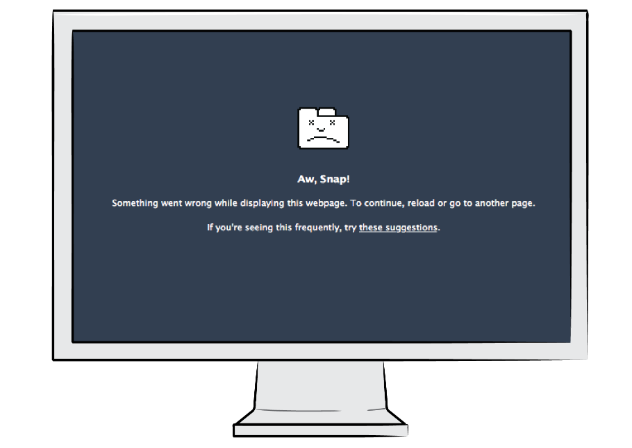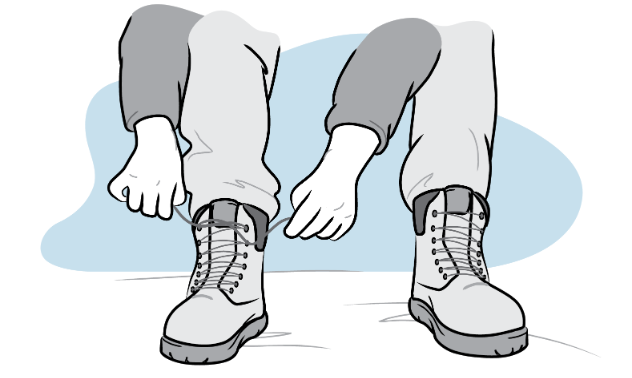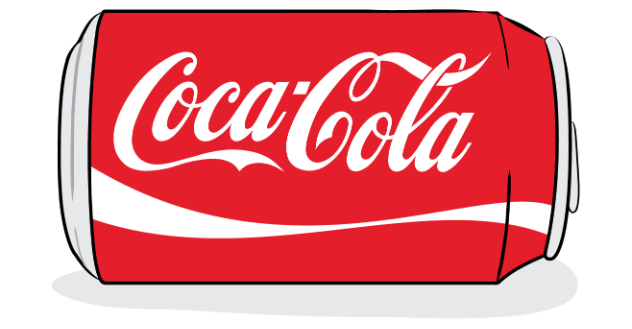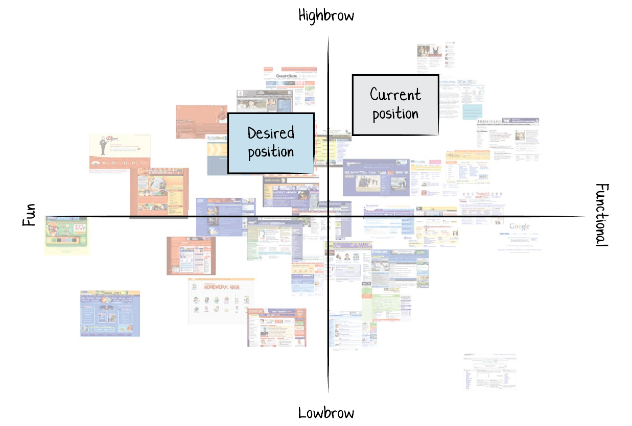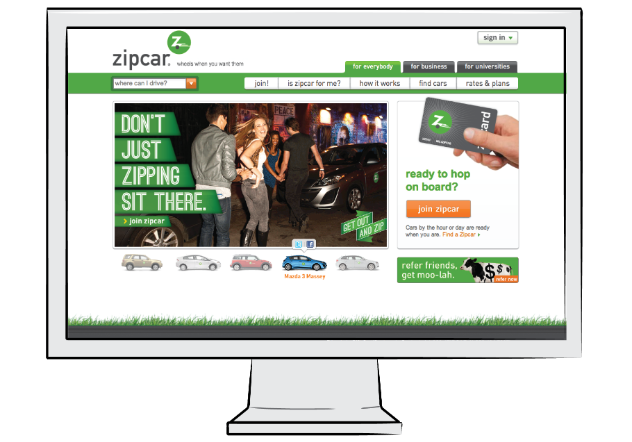We use web browsers every day and don’t really think about them until something goes wrong. Google Chrome crashed on me the other day and I got the iconic “Aw, Snap!” page with the unhappy folder icon. Instead of being cross at the error, it made me smile, and I was more forgiving of the browser for crashing. This is an example of how personality can engage customers’ emotions and help them build a stronger relationship with your brand.
While predictability, efficiency, and convenience are assumed for worthwhile product or service experiences in today’s market, just being ‘useful’ is no longer sufficient. Successful experiences are those that are coveted. Customers will sometimes covet products or services that are not logically the best choice but appeal to them on an emotional level. This attachment can take their relationship with a brand beyond a mere marriage of convenience, to the meeting of soul mates.
Why Personality Matters
A strong personality differentiates a brand’s products or services, especially in globally competitive markets.1
It has long been accepted that customers don’t choose products based on their features alone, but also base their selections on symbolic value. When a customer identifies with the personality of a brand, it can mimic the relationship between people2. This inspires trust, encourages brand loyalty, and makes a brand memorable. The willingness of Apple fans to wait patiently for upgrades, forgive Apple its flaws, and defend the company against detractors is a demonstration of their strong relationship with the brand.
A strong personality is particularly important for challengers. It enables them to make each of their interactions count, forging stronger connections than the dominant competitor.
What is Brand Personality?
As Aarron Walter argues in his book Designing for Emotion 3, “Personality is the mysterious force that attracts us to certain people and repels us from others.” Customers easily stretch that concept beyond purely human relationships to their dealings with services and products.
Personality is the character of a brand
Customers often use terms to describe brand personalities that appear to go beyond the psychological definition of “personality” because they involve gender, age, or socioeconomic4,5 status. For example, when describing Timberland, customers use terms such as “traditional,” “male,” and “adventurous.” But terms like “male” can be shorthand for stereotypical personality traits (like “aggressiveness” or “ruggedness”). Descriptors that are relevant to personality always indicate the perception of how a brand typically thinks and behaves – its character.
Good brand personality makes good company
Customers normally say that a brand has a personality if they think of it positively. Rohit Bhargaya notes this connection between positivity and personality in Personality Not Included, stating “[Brand] personality is the unique, authentic, and talkable soul of your brand that people can get passionate about.”
But this is not the whole story. For example, brands that people claim have no personality are most often associated with dominant telcos or banks. But when asked to describe these companies as a person, customers give vivid, although mostly negative descriptors such as “dull,” “greedy,” and “faceless.” So perceived lack of brand personality usually means an unattractive or weak personality.
Shaping a Brand’s Personality
Take a customer-centred design approach to defining a brand’s personality so it is authentic and resonates with the target customers.
Know the target market
The appeal of a brand’s personality will depend on its customers’ personalities. Customers prefer brands that align with their self-image (the Self-Expression Model6), or that would suit the ‘partnership’ they enter into with the brand (the Relationship Basis Model). Gaining an intimate knowledge of customer behaviors, needs, and goals is crucial when building a brand’s personality.
One size doesn’t fit all
Weak brand personalities arise, especially among dominant market players, when they try to appeal to everybody. Starbucks had a strong personality, but since it has expanded worldwide it has become faceless. When Starbucks first opened a coffee house in 1984 it was a challenger in the market. It offered European-style coffee houses unique in the U.S. market and focused on quality, freshness, and an individual experience7. In Starbucks’ global domination that followed in 1999, the uniqueness and brand authenticity were weakened. According to Howard Schultz, founder of Starbucks, “The key threat to the Starbucks brand was a growing belief among customers that the company was becoming corporate, predictable, inaccessible or irrelevant… Clearly we had not told our story well enough.”8
To your self be true
A strong brand personality requires a company to create authentic brand values. These values permeate through the organization, affecting policies, attitudes of staff, and the company’s culture. A clear example is in Google’s company philosophy: “You can make money without doing evil.”9 This value initially directed the organization to make decisions focused on its customers’ needs, not on profitability alone. Values must be evidenced in corporate behavior lest public trust be eroded. Google has recently been accused of being hypocritical for this reason.10
Communicating Personality
Customers’ trust in a brand’s personality depends on how consistently it is communicated across all the touchpoints they interact with. Ensure there’s alignment within the teams that design the visual clues of your product or service, as well as those that craft written and oral communications.
I can tell by the way you look…
One of the first things that determines a brand’s personality is how it looks. Visual information is symbolic as well as aesthetic, and is arguably the fastest track to conveying personality. Visual channels incorporate all the tangible touchpoints of your product or service: the website, retail spaces, brochures, uniforms, videos, products, etc.
All visual elements and principles such as color, balance, harmony, and contrast work together to display a brand’s personality. Coca-Cola, for example, uses distinctive white cursive script on a bright red logo to demonstrate its ”happy,” “bold,” and “authentic” brand personality. The association of the color red with danger, lipstick, and love all conjure up this impression11. The nostalgic custom white typeface also gives a feeling of history, reinforcing the authenticity attribute.
Voice mapping is a technique that can be used to purposely define where you want to position a brand on a semiotic level. The brand’s current and future positions are mapped on orthogonal personality attribute axes in comparison to the competitive landscape. A visual designer then interprets that position in the visual channel and drives the design in the chosen direction. Designs can then be checked against the desired position on the voice map to ensure consistency.
It’s the tone that counts
Every time customers read something on a company’s website or chat with its staff, they make judgements about its brand personality based on tone of voice. A company’s tone of voice across written or oral communication demonstrates its brand personality. If a person keeps changing his tone of voice radically with each interaction, one is inclined to trust him less; the same is true for brands. To be believable and appear authentic to customers, the company’s tone of voice needs to sound human and be consistent.
For example, if the brand personality is “informal” and “humorous,” its language should match this. In Gmail for instance, the label “Under the hood” replaces the usual “Advanced settings,” and options for the layout of emails include “Comfortable” and “Cozy.” Humor is used in an understated, playful way. Even though Google’s staff has virtually no direct contact with its customers, its personality shines through in its language.
A simple trick to ensure an authentic, human-sounding voice is to read aloud any text you want customer to read. If it sounds odd to you, then it will to customers. To ensure authenticity, consider how your tone of voice should modulate to suit the “mood” of the customer. For example, if a customer encounters an error in the purchase process on a website, the tone of voice needs to change to apologetic to fit the mood. Voice mapping can again be used to ensure tone of voice is consistent across all communications.
Empower staff
A company’s staff is often instructed to use restrictive scripts in the belief that this will deliver a consistent brand message. But scripted interactions often feel robotic, at odds with human personality. It is more effective (and authentic) to educate staff on brand values and let them deliver the message in their own unique ways. Hiring staff that understand and share the same values is a sure-fire way of ensuring they stay on message. Zipcar is an example of a company that reinforces its personality (“young,” “playful,” and “environmentally conscious”) in its recruitment strategy. The Zipcar website states: “We’re looking for clever and conscientious people to work in a supportive and diverse environment. Hint: a personality as fun as our brand is not just a plus—it’s A+.” To weed out undesirable mismatches in staff–brand values, Zipcar’s job descriptions even include requirements for “walking or using public transport to get to work” and being “fun to be around.”
To err is human…
Making mistakes is human, its how one recovers from them that demonstrates personality and helps build a brand’s credibility. Empower and encourage staff to use negative moments as opportunities to create positive experiences for customers that contribute to the personal story of brand. Southwest Airlines have a specialized team dedicated to a proactive style of customer service that spots mistakes, apologizes for them, and tries to compensate customers accordingly. This honesty and willing assumption of responsibility helps earns customers’ trust and loyalty. According to John Tschohl, an international management consultant and customer-service expert, “What separates service leaders from the rest of the pack is how they handle those mistakes, how they meet the challenge of turning a disgruntled customer into one who sings their praises and becomes a customer for life.”12
Checklists for Brand Personality
Checklist for UX professionals
- Understand the brand personality and how it can support users’ behaviors, needs, and goals.
- Adhere to brand values to ensure consistency across all channels.
- Collaborate with specialists in other disciplines (e.g., visual designers, writers, artists, musicians, and spatial designers) to ensure personality is conveyed effectively across all media.
- Use tools such as voice maps to position verbal and visual brand positioning.
- Read aloud everything you expect the user to read to make sure it sounds human.
- Consider how to adapt tone of voice to match the moods of customers.
Checklist for business
- Crystallize the brand’s personality by defining its values and vision.
- Convey the company’s personality consistently and authentically across all channels.
- Employ staff who align with the culture and values of your company.
- Create policies that empower staff to convey the brand personality in their own way.
The Risks and Limitations of Brand Personality
Personality can help recover from mistakes but can’t make up for a bad product
While a strong personality will initially satisfy customers, eventually the disconnect between an authentic personality and useless product will undermine the brand. If a product is really unsuitable, a good personality won’t help. Generally, ideas that offer a solid value proposition to customers are those that naturally fit within a plausible scenario of use.
Social norms also determine personality
Consumers often have prior assumptions about the personality of a brand depending on the product or service category it belongs to. For example, customers might assume that banks are “traditional,” “conservative,” “complex,” and ” bureaucratic.” Organizations face a challenge if they wish to diverge from deep-seated preconceptions in order to differentiate their brand. ING Direct is an example of a challenger brand in the banking marketplace that fought against these preconceptions. According to the CEO Don Koch, “We pride ourselves on making the customer experience simple and straight forward.”13 Simplicity is a difficult brand vision for a bank to achieve. However, in 2009 ING Direct boasted a 76% customer satisfaction rate, the highest of any bank in Australia.14
Personality is not easily transferrable
Sometimes the existing personality of a brand doesn’t suit the company’s desired target market. Strong brand personalities are inherently linked to particular products and users, and are therefore not easily extendable or transferrable. Companies can overcome the legacy of an established brand by releasing sub-brands or new brands that are specifically targeted to the market. For example Virgin Blue, a low-cost Australian domestic airline, wanted to compete for a larger market share from the dominant, business-traveller-focused Qantas in 2011. To successfully overcome Virgin Blue’s existing brand personality traits of “cheap” and “fun,” they rebranded as Virgin Australia. They changed their personality from everyday to aspirational with more subdued branding, luxurious aircraft, chef-prepared menus, valet parking, stylish uniforms, and a new focus on the business traveller.15
Conclusion
A single, consistent brand personality is the foundation for a strong long-term relationship between a company and its customers. Like all relationships this bond is founded on a perception of trust, which means customers require authentic engagement. Customers are more likely to engage with a brand personality if it is closely aligned with their own personality and values.
The key to delivering that personality across all service or product touch points is consistency rather than mimicry. It is achieved by building alignment within design teams, and by recruiting staff to deliver the services that align with the brand’s personality.
Mastering personality is key to a strong customer relationship, but it is only the fourth step in building a truly customer-centric business. Once you appeal to your target market with a strong personality, how do you ensure customers feel like individuals, and not just one of many? In the next article in this series we will discuss the value of personal in user experience.
References:
- Bhargava, R. (2008). Personality Not Included: Why Companies Lose Their Authenticity And How Great Brands Get it Back. United States: McGraw-Hill Professional
- Aaker, D. A. (1996) Building Strong Brands. New York: The Free Press
- Walter, A (2011) Designing for Emotion. A Book Apart.
- Azoulay, A., & Kapferer, J. N. (2003). Do brand personality scales really measure brand personality? Brand Management, 11(2) 143-155.
- Puzakova, M., Kwak, H. & Rocereto, J. F. (2009) Pushing the Envelope of Brand Personality: Antecedents and Moderators of Anthropomorphized Brands. Advances in Consumer Research. 36, 413-420
- Malär, L., Krohmer, H., Hoyer, W. D., Nyffenegger, B. (2011) Emotional Brand Attachment and Brand Personality: The Relative Importance of the Actual and the Ideal Self. Journal of Marketing. 75(4), 35-52
- Starbucks Company Timeline 2011, retrieved April 4, 2012 from Starbucks Coffee Company
- Schultz ,H., Jones Yang, D. (1997) Pour Your Heart Into It: How Starbucks Built a Company One Cup at a Time. USA: Hyperion
- Ten things we know to be true. Retrieved April 5, 2012, from Google – Company – What we believe
- Honan, M. (2012, January 24) Google’s Broken Promise: The End of “Don’t Be Evil”. Retrieved March 26, 2012, from Gizmodo
- Morton, J. (2011) The Meanings of Red, retrieved March 26, 2012, from Color Matters
- Mak (2011) Why Selling Sucks & Building Relationships Work: A Practical & Definitive Guide for the Frontline Service Staff. Canada: Trafford Publishing, p426
- ING Direct (2009, September 1) ING Direct tops customer satisfaction ratings, retrieved April 3, 2012 from infochoice
- Breen, D. (2009, August 31) ING Direct tops customer satisfaction rating, retrieved on April 3, 2012 from ING Direct
- Flynn, D. (2011, May 4) Virgin Blue to relaunch today as Virgin Australia, retrieved April 4 from Australian Business Traveller
- Banner Image Credit: Wikimedia Commons
Illustrations by Nam Nguyen


